European Union and North America: A Deep Dive into Relations
VerifiedAdded on 2022/10/04
|17
|4346
|19
Essay
AI Summary
This paper provides a comprehensive analysis of the relationship between the European Union and North America, specifically focusing on the United States and Canada. It begins with an executive summary and table of contents, followed by an introduction that defines the context of the Cold War and the concept of "the West." The discussion section delves into the historical background, highlighting the post-World War II conditions and the emergence of the EU. It examines the international situation in the 1970s, including the impact of the Vietnam War and the oil crises, and how these events shaped the relationship between the EU and North America. The paper then explores the specific relationships between the EU and the US, and the EU and Canada. The paper concludes by summarizing the key points and offering insights into the enduring nature of these transatlantic relationships.
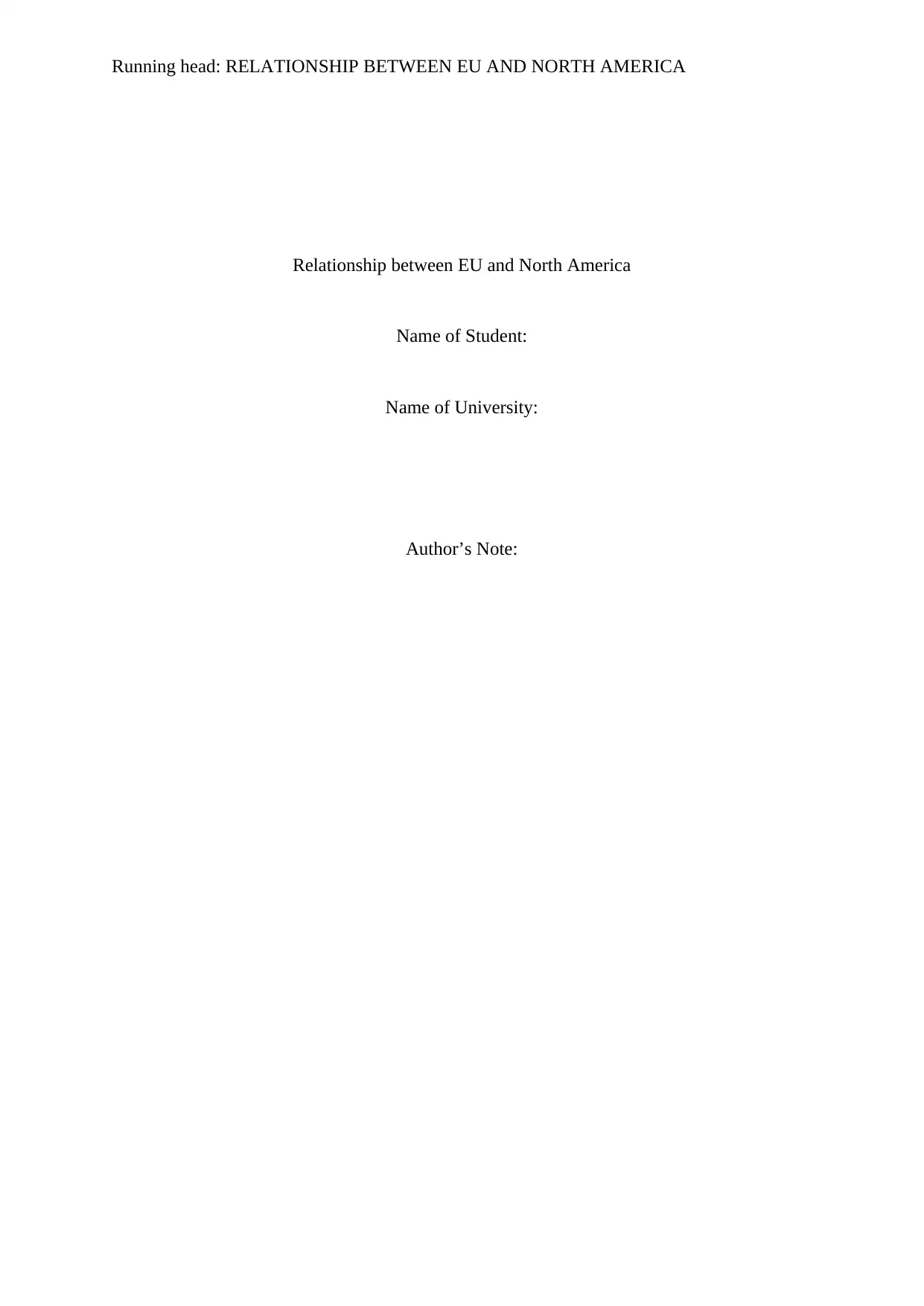
Running head: RELATIONSHIP BETWEEN EU AND NORTH AMERICA
Relationship between EU and North America
Name of Student:
Name of University:
Author’s Note:
Relationship between EU and North America
Name of Student:
Name of University:
Author’s Note:
Paraphrase This Document
Need a fresh take? Get an instant paraphrase of this document with our AI Paraphraser
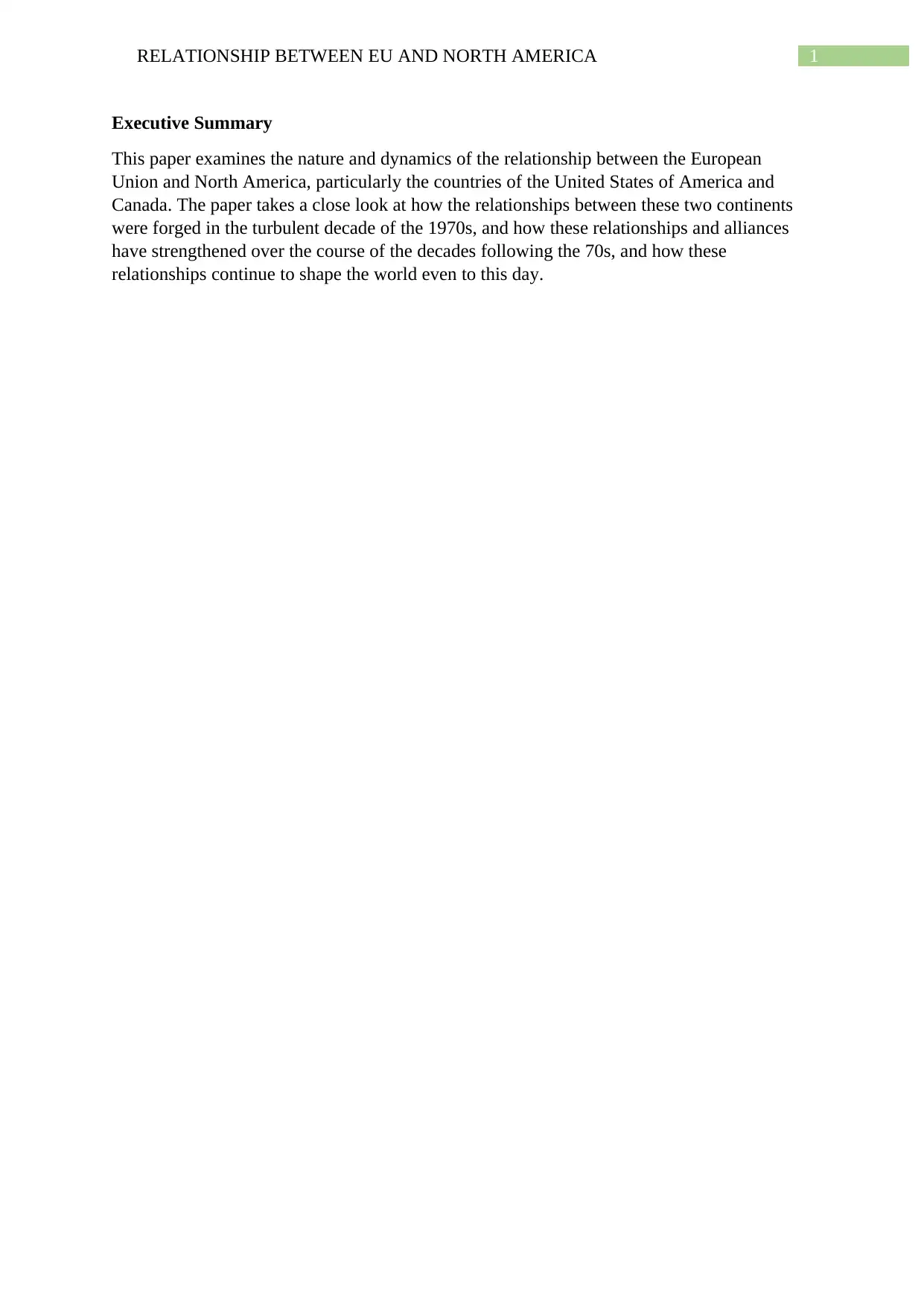
1RELATIONSHIP BETWEEN EU AND NORTH AMERICA
Executive Summary
This paper examines the nature and dynamics of the relationship between the European
Union and North America, particularly the countries of the United States of America and
Canada. The paper takes a close look at how the relationships between these two continents
were forged in the turbulent decade of the 1970s, and how these relationships and alliances
have strengthened over the course of the decades following the 70s, and how these
relationships continue to shape the world even to this day.
Executive Summary
This paper examines the nature and dynamics of the relationship between the European
Union and North America, particularly the countries of the United States of America and
Canada. The paper takes a close look at how the relationships between these two continents
were forged in the turbulent decade of the 1970s, and how these relationships and alliances
have strengthened over the course of the decades following the 70s, and how these
relationships continue to shape the world even to this day.
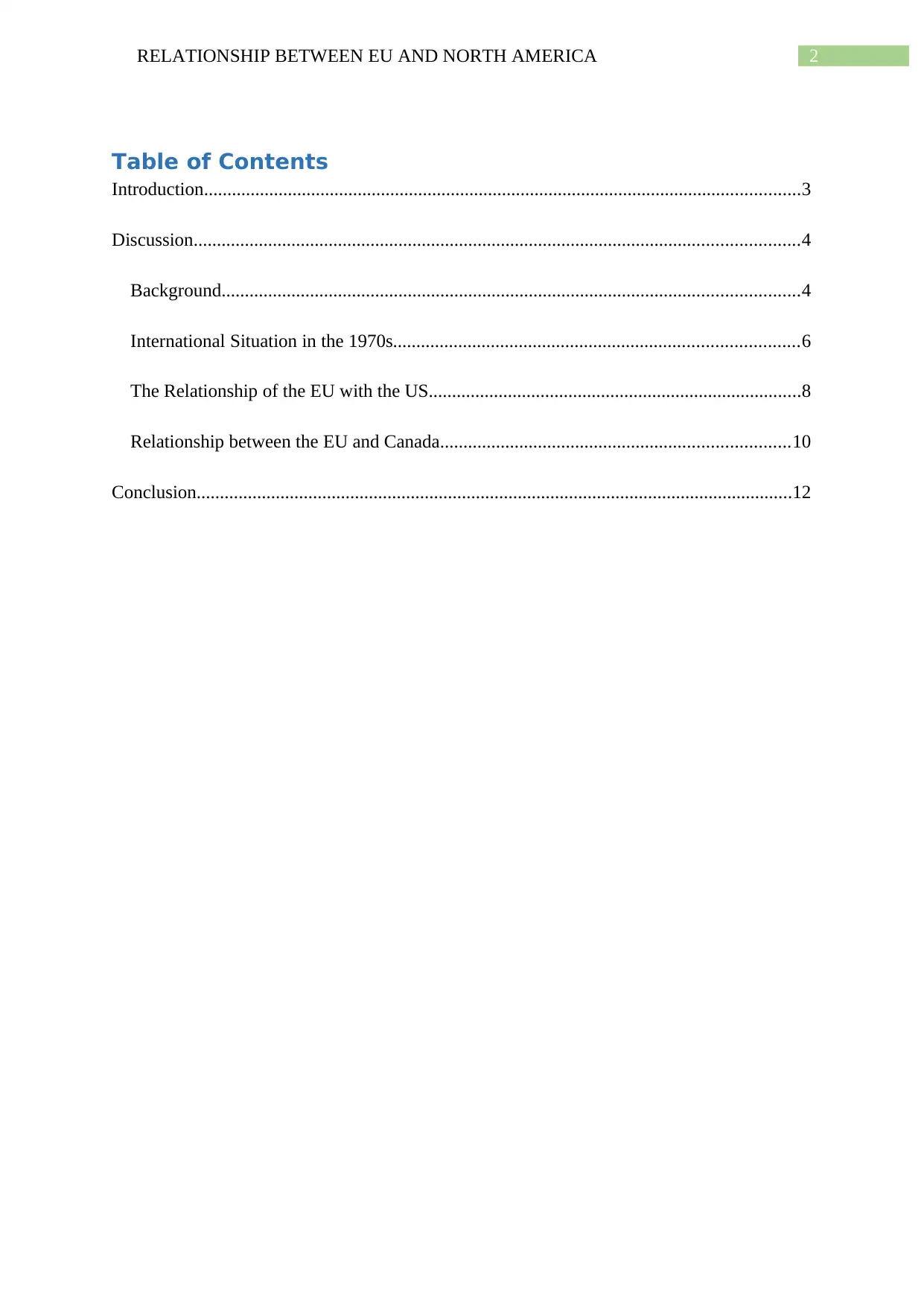
2RELATIONSHIP BETWEEN EU AND NORTH AMERICA
Table of Contents
Introduction................................................................................................................................3
Discussion..................................................................................................................................4
Background............................................................................................................................4
International Situation in the 1970s.......................................................................................6
The Relationship of the EU with the US................................................................................8
Relationship between the EU and Canada...........................................................................10
Conclusion................................................................................................................................12
Table of Contents
Introduction................................................................................................................................3
Discussion..................................................................................................................................4
Background............................................................................................................................4
International Situation in the 1970s.......................................................................................6
The Relationship of the EU with the US................................................................................8
Relationship between the EU and Canada...........................................................................10
Conclusion................................................................................................................................12
⊘ This is a preview!⊘
Do you want full access?
Subscribe today to unlock all pages.

Trusted by 1+ million students worldwide
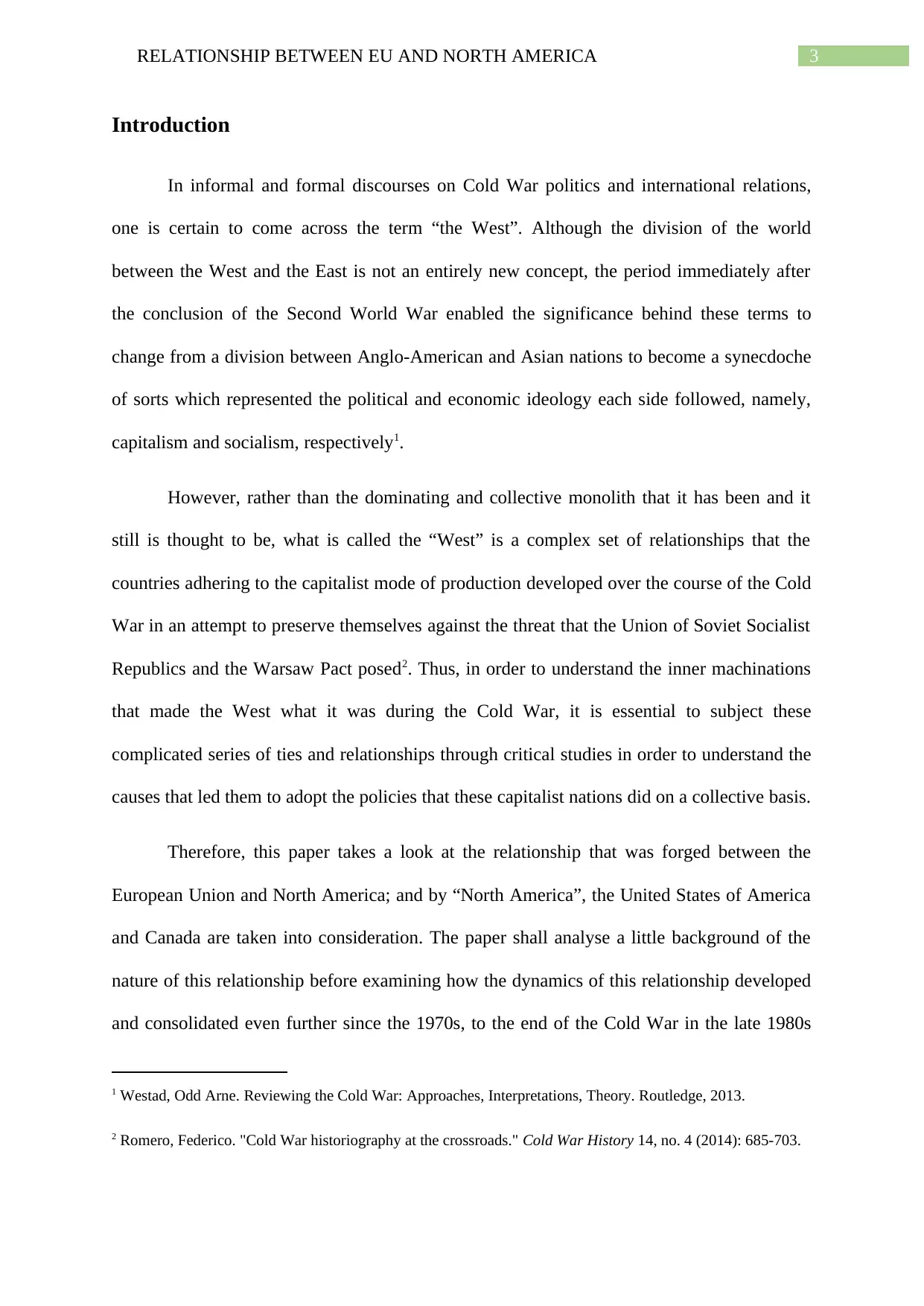
3RELATIONSHIP BETWEEN EU AND NORTH AMERICA
Introduction
In informal and formal discourses on Cold War politics and international relations,
one is certain to come across the term “the West”. Although the division of the world
between the West and the East is not an entirely new concept, the period immediately after
the conclusion of the Second World War enabled the significance behind these terms to
change from a division between Anglo-American and Asian nations to become a synecdoche
of sorts which represented the political and economic ideology each side followed, namely,
capitalism and socialism, respectively1.
However, rather than the dominating and collective monolith that it has been and it
still is thought to be, what is called the “West” is a complex set of relationships that the
countries adhering to the capitalist mode of production developed over the course of the Cold
War in an attempt to preserve themselves against the threat that the Union of Soviet Socialist
Republics and the Warsaw Pact posed2. Thus, in order to understand the inner machinations
that made the West what it was during the Cold War, it is essential to subject these
complicated series of ties and relationships through critical studies in order to understand the
causes that led them to adopt the policies that these capitalist nations did on a collective basis.
Therefore, this paper takes a look at the relationship that was forged between the
European Union and North America; and by “North America”, the United States of America
and Canada are taken into consideration. The paper shall analyse a little background of the
nature of this relationship before examining how the dynamics of this relationship developed
and consolidated even further since the 1970s, to the end of the Cold War in the late 1980s
1 Westad, Odd Arne. Reviewing the Cold War: Approaches, Interpretations, Theory. Routledge, 2013.
2 Romero, Federico. "Cold War historiography at the crossroads." Cold War History 14, no. 4 (2014): 685-703.
Introduction
In informal and formal discourses on Cold War politics and international relations,
one is certain to come across the term “the West”. Although the division of the world
between the West and the East is not an entirely new concept, the period immediately after
the conclusion of the Second World War enabled the significance behind these terms to
change from a division between Anglo-American and Asian nations to become a synecdoche
of sorts which represented the political and economic ideology each side followed, namely,
capitalism and socialism, respectively1.
However, rather than the dominating and collective monolith that it has been and it
still is thought to be, what is called the “West” is a complex set of relationships that the
countries adhering to the capitalist mode of production developed over the course of the Cold
War in an attempt to preserve themselves against the threat that the Union of Soviet Socialist
Republics and the Warsaw Pact posed2. Thus, in order to understand the inner machinations
that made the West what it was during the Cold War, it is essential to subject these
complicated series of ties and relationships through critical studies in order to understand the
causes that led them to adopt the policies that these capitalist nations did on a collective basis.
Therefore, this paper takes a look at the relationship that was forged between the
European Union and North America; and by “North America”, the United States of America
and Canada are taken into consideration. The paper shall analyse a little background of the
nature of this relationship before examining how the dynamics of this relationship developed
and consolidated even further since the 1970s, to the end of the Cold War in the late 1980s
1 Westad, Odd Arne. Reviewing the Cold War: Approaches, Interpretations, Theory. Routledge, 2013.
2 Romero, Federico. "Cold War historiography at the crossroads." Cold War History 14, no. 4 (2014): 685-703.
Paraphrase This Document
Need a fresh take? Get an instant paraphrase of this document with our AI Paraphraser
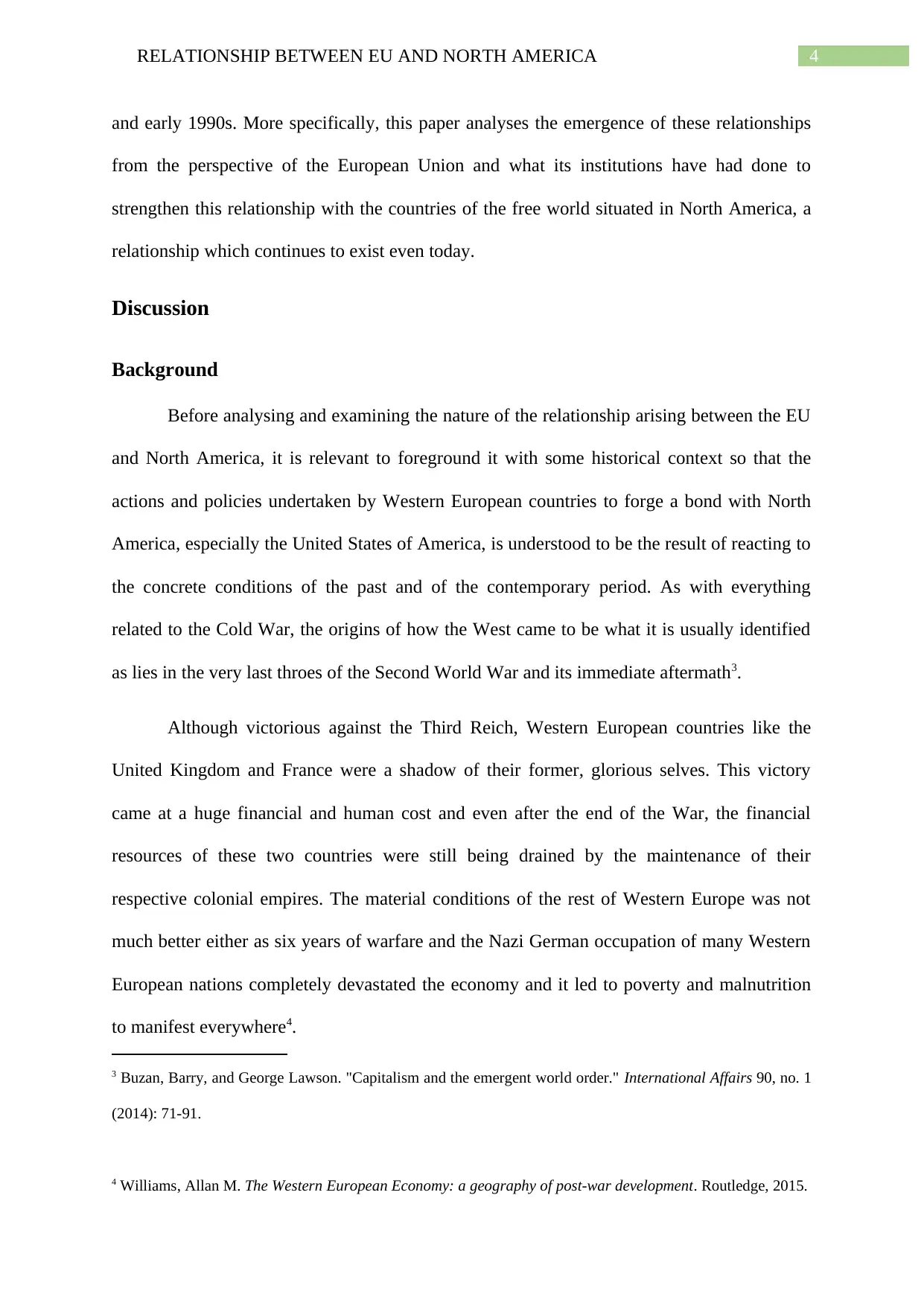
4RELATIONSHIP BETWEEN EU AND NORTH AMERICA
and early 1990s. More specifically, this paper analyses the emergence of these relationships
from the perspective of the European Union and what its institutions have had done to
strengthen this relationship with the countries of the free world situated in North America, a
relationship which continues to exist even today.
Discussion
Background
Before analysing and examining the nature of the relationship arising between the EU
and North America, it is relevant to foreground it with some historical context so that the
actions and policies undertaken by Western European countries to forge a bond with North
America, especially the United States of America, is understood to be the result of reacting to
the concrete conditions of the past and of the contemporary period. As with everything
related to the Cold War, the origins of how the West came to be what it is usually identified
as lies in the very last throes of the Second World War and its immediate aftermath3.
Although victorious against the Third Reich, Western European countries like the
United Kingdom and France were a shadow of their former, glorious selves. This victory
came at a huge financial and human cost and even after the end of the War, the financial
resources of these two countries were still being drained by the maintenance of their
respective colonial empires. The material conditions of the rest of Western Europe was not
much better either as six years of warfare and the Nazi German occupation of many Western
European nations completely devastated the economy and it led to poverty and malnutrition
to manifest everywhere4.
3 Buzan, Barry, and George Lawson. "Capitalism and the emergent world order." International Affairs 90, no. 1
(2014): 71-91.
4 Williams, Allan M. The Western European Economy: a geography of post-war development. Routledge, 2015.
and early 1990s. More specifically, this paper analyses the emergence of these relationships
from the perspective of the European Union and what its institutions have had done to
strengthen this relationship with the countries of the free world situated in North America, a
relationship which continues to exist even today.
Discussion
Background
Before analysing and examining the nature of the relationship arising between the EU
and North America, it is relevant to foreground it with some historical context so that the
actions and policies undertaken by Western European countries to forge a bond with North
America, especially the United States of America, is understood to be the result of reacting to
the concrete conditions of the past and of the contemporary period. As with everything
related to the Cold War, the origins of how the West came to be what it is usually identified
as lies in the very last throes of the Second World War and its immediate aftermath3.
Although victorious against the Third Reich, Western European countries like the
United Kingdom and France were a shadow of their former, glorious selves. This victory
came at a huge financial and human cost and even after the end of the War, the financial
resources of these two countries were still being drained by the maintenance of their
respective colonial empires. The material conditions of the rest of Western Europe was not
much better either as six years of warfare and the Nazi German occupation of many Western
European nations completely devastated the economy and it led to poverty and malnutrition
to manifest everywhere4.
3 Buzan, Barry, and George Lawson. "Capitalism and the emergent world order." International Affairs 90, no. 1
(2014): 71-91.
4 Williams, Allan M. The Western European Economy: a geography of post-war development. Routledge, 2015.
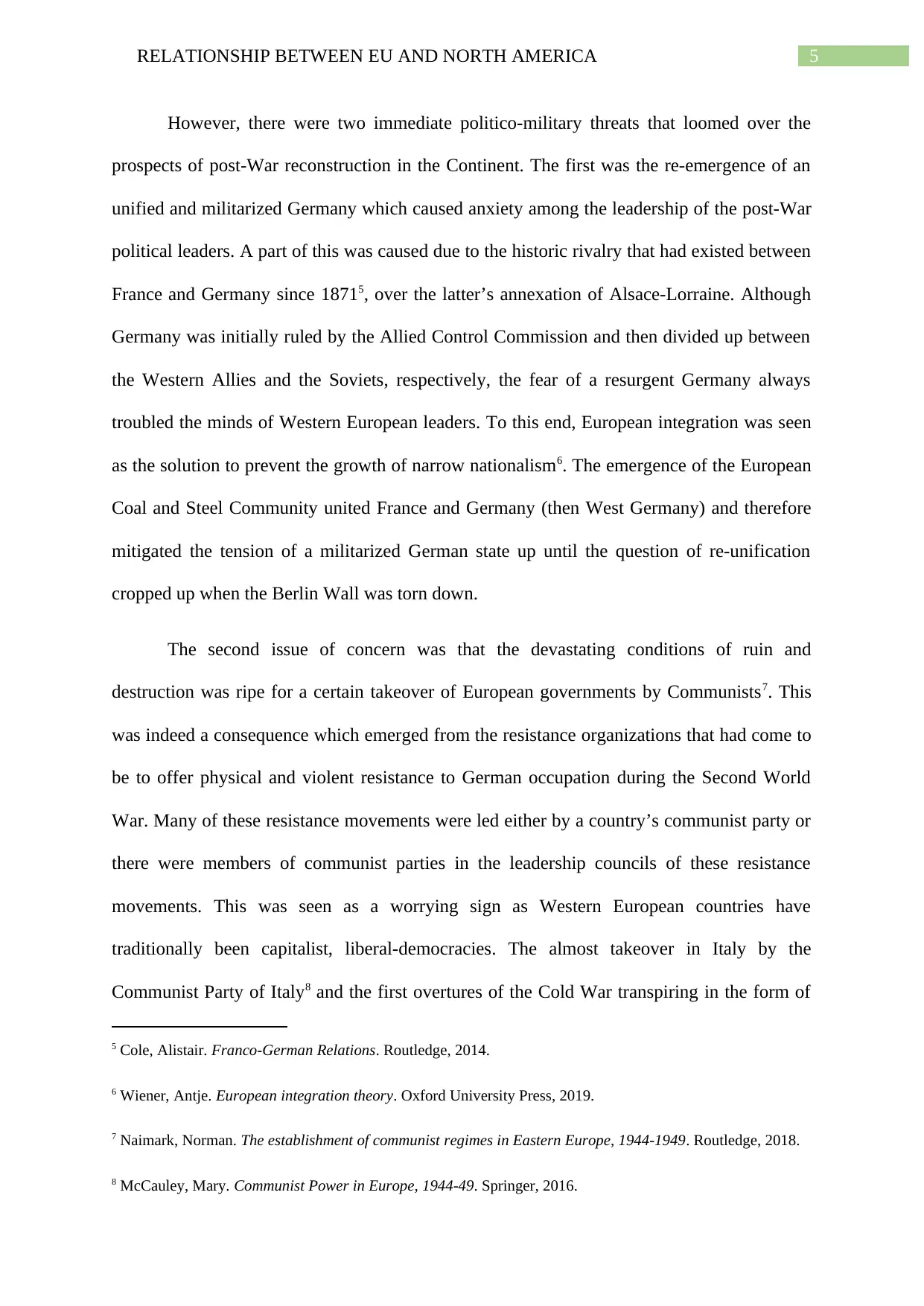
5RELATIONSHIP BETWEEN EU AND NORTH AMERICA
However, there were two immediate politico-military threats that loomed over the
prospects of post-War reconstruction in the Continent. The first was the re-emergence of an
unified and militarized Germany which caused anxiety among the leadership of the post-War
political leaders. A part of this was caused due to the historic rivalry that had existed between
France and Germany since 18715, over the latter’s annexation of Alsace-Lorraine. Although
Germany was initially ruled by the Allied Control Commission and then divided up between
the Western Allies and the Soviets, respectively, the fear of a resurgent Germany always
troubled the minds of Western European leaders. To this end, European integration was seen
as the solution to prevent the growth of narrow nationalism6. The emergence of the European
Coal and Steel Community united France and Germany (then West Germany) and therefore
mitigated the tension of a militarized German state up until the question of re-unification
cropped up when the Berlin Wall was torn down.
The second issue of concern was that the devastating conditions of ruin and
destruction was ripe for a certain takeover of European governments by Communists7. This
was indeed a consequence which emerged from the resistance organizations that had come to
be to offer physical and violent resistance to German occupation during the Second World
War. Many of these resistance movements were led either by a country’s communist party or
there were members of communist parties in the leadership councils of these resistance
movements. This was seen as a worrying sign as Western European countries have
traditionally been capitalist, liberal-democracies. The almost takeover in Italy by the
Communist Party of Italy8 and the first overtures of the Cold War transpiring in the form of
5 Cole, Alistair. Franco-German Relations. Routledge, 2014.
6 Wiener, Antje. European integration theory. Oxford University Press, 2019.
7 Naimark, Norman. The establishment of communist regimes in Eastern Europe, 1944-1949. Routledge, 2018.
8 McCauley, Mary. Communist Power in Europe, 1944-49. Springer, 2016.
However, there were two immediate politico-military threats that loomed over the
prospects of post-War reconstruction in the Continent. The first was the re-emergence of an
unified and militarized Germany which caused anxiety among the leadership of the post-War
political leaders. A part of this was caused due to the historic rivalry that had existed between
France and Germany since 18715, over the latter’s annexation of Alsace-Lorraine. Although
Germany was initially ruled by the Allied Control Commission and then divided up between
the Western Allies and the Soviets, respectively, the fear of a resurgent Germany always
troubled the minds of Western European leaders. To this end, European integration was seen
as the solution to prevent the growth of narrow nationalism6. The emergence of the European
Coal and Steel Community united France and Germany (then West Germany) and therefore
mitigated the tension of a militarized German state up until the question of re-unification
cropped up when the Berlin Wall was torn down.
The second issue of concern was that the devastating conditions of ruin and
destruction was ripe for a certain takeover of European governments by Communists7. This
was indeed a consequence which emerged from the resistance organizations that had come to
be to offer physical and violent resistance to German occupation during the Second World
War. Many of these resistance movements were led either by a country’s communist party or
there were members of communist parties in the leadership councils of these resistance
movements. This was seen as a worrying sign as Western European countries have
traditionally been capitalist, liberal-democracies. The almost takeover in Italy by the
Communist Party of Italy8 and the first overtures of the Cold War transpiring in the form of
5 Cole, Alistair. Franco-German Relations. Routledge, 2014.
6 Wiener, Antje. European integration theory. Oxford University Press, 2019.
7 Naimark, Norman. The establishment of communist regimes in Eastern Europe, 1944-1949. Routledge, 2018.
8 McCauley, Mary. Communist Power in Europe, 1944-49. Springer, 2016.
⊘ This is a preview!⊘
Do you want full access?
Subscribe today to unlock all pages.

Trusted by 1+ million students worldwide
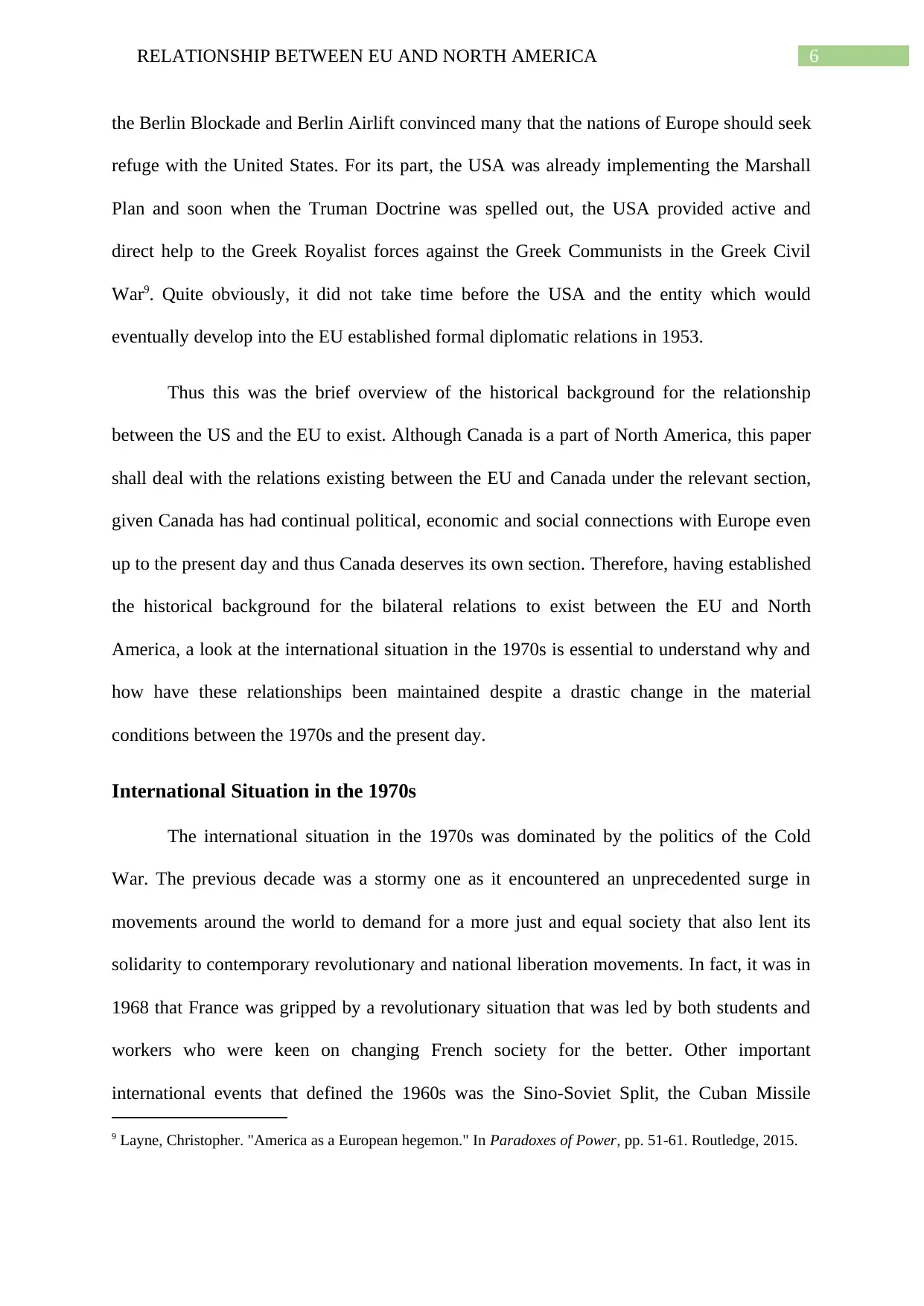
6RELATIONSHIP BETWEEN EU AND NORTH AMERICA
the Berlin Blockade and Berlin Airlift convinced many that the nations of Europe should seek
refuge with the United States. For its part, the USA was already implementing the Marshall
Plan and soon when the Truman Doctrine was spelled out, the USA provided active and
direct help to the Greek Royalist forces against the Greek Communists in the Greek Civil
War9. Quite obviously, it did not take time before the USA and the entity which would
eventually develop into the EU established formal diplomatic relations in 1953.
Thus this was the brief overview of the historical background for the relationship
between the US and the EU to exist. Although Canada is a part of North America, this paper
shall deal with the relations existing between the EU and Canada under the relevant section,
given Canada has had continual political, economic and social connections with Europe even
up to the present day and thus Canada deserves its own section. Therefore, having established
the historical background for the bilateral relations to exist between the EU and North
America, a look at the international situation in the 1970s is essential to understand why and
how have these relationships been maintained despite a drastic change in the material
conditions between the 1970s and the present day.
International Situation in the 1970s
The international situation in the 1970s was dominated by the politics of the Cold
War. The previous decade was a stormy one as it encountered an unprecedented surge in
movements around the world to demand for a more just and equal society that also lent its
solidarity to contemporary revolutionary and national liberation movements. In fact, it was in
1968 that France was gripped by a revolutionary situation that was led by both students and
workers who were keen on changing French society for the better. Other important
international events that defined the 1960s was the Sino-Soviet Split, the Cuban Missile
9 Layne, Christopher. "America as a European hegemon." In Paradoxes of Power, pp. 51-61. Routledge, 2015.
the Berlin Blockade and Berlin Airlift convinced many that the nations of Europe should seek
refuge with the United States. For its part, the USA was already implementing the Marshall
Plan and soon when the Truman Doctrine was spelled out, the USA provided active and
direct help to the Greek Royalist forces against the Greek Communists in the Greek Civil
War9. Quite obviously, it did not take time before the USA and the entity which would
eventually develop into the EU established formal diplomatic relations in 1953.
Thus this was the brief overview of the historical background for the relationship
between the US and the EU to exist. Although Canada is a part of North America, this paper
shall deal with the relations existing between the EU and Canada under the relevant section,
given Canada has had continual political, economic and social connections with Europe even
up to the present day and thus Canada deserves its own section. Therefore, having established
the historical background for the bilateral relations to exist between the EU and North
America, a look at the international situation in the 1970s is essential to understand why and
how have these relationships been maintained despite a drastic change in the material
conditions between the 1970s and the present day.
International Situation in the 1970s
The international situation in the 1970s was dominated by the politics of the Cold
War. The previous decade was a stormy one as it encountered an unprecedented surge in
movements around the world to demand for a more just and equal society that also lent its
solidarity to contemporary revolutionary and national liberation movements. In fact, it was in
1968 that France was gripped by a revolutionary situation that was led by both students and
workers who were keen on changing French society for the better. Other important
international events that defined the 1960s was the Sino-Soviet Split, the Cuban Missile
9 Layne, Christopher. "America as a European hegemon." In Paradoxes of Power, pp. 51-61. Routledge, 2015.
Paraphrase This Document
Need a fresh take? Get an instant paraphrase of this document with our AI Paraphraser
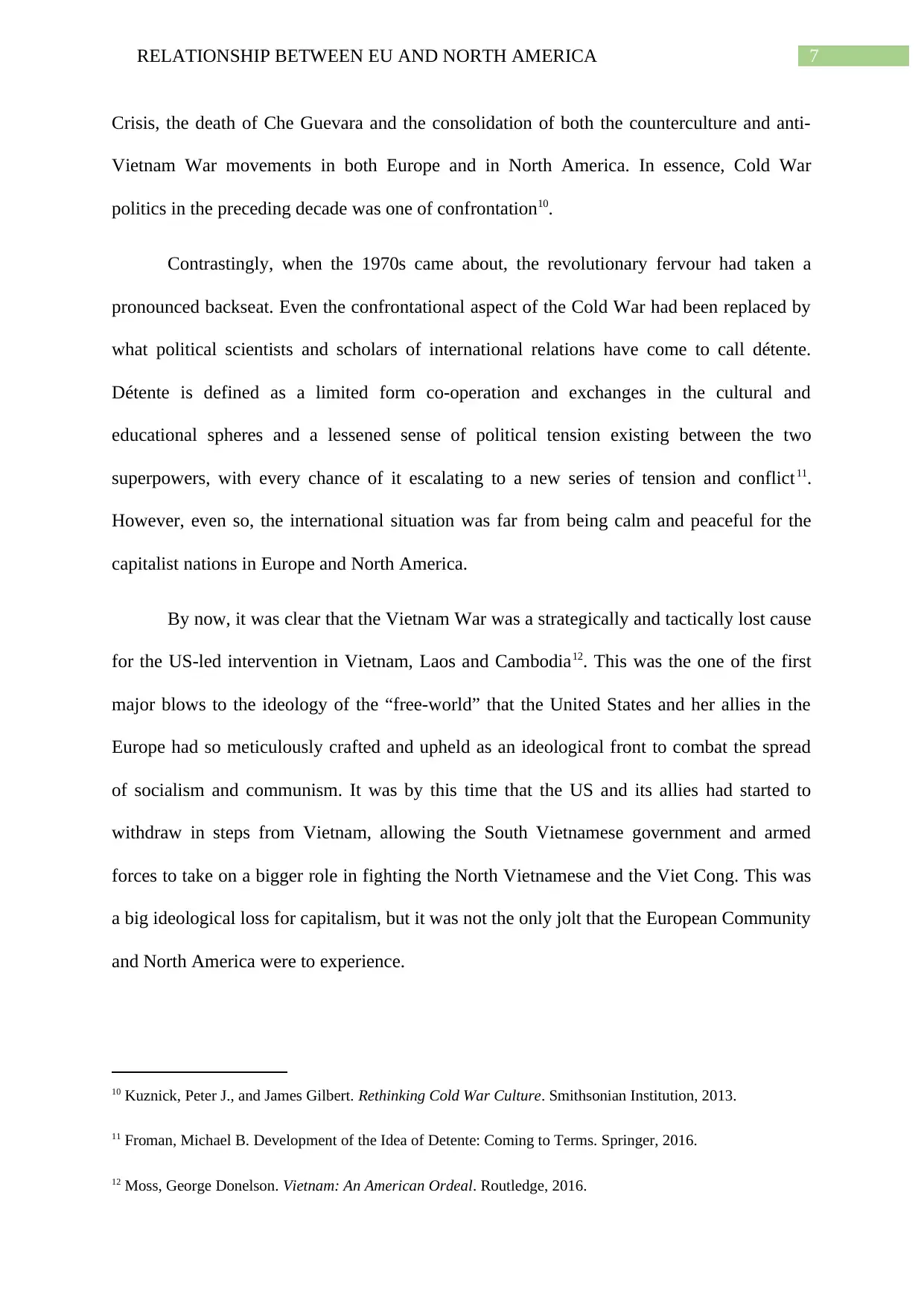
7RELATIONSHIP BETWEEN EU AND NORTH AMERICA
Crisis, the death of Che Guevara and the consolidation of both the counterculture and anti-
Vietnam War movements in both Europe and in North America. In essence, Cold War
politics in the preceding decade was one of confrontation10.
Contrastingly, when the 1970s came about, the revolutionary fervour had taken a
pronounced backseat. Even the confrontational aspect of the Cold War had been replaced by
what political scientists and scholars of international relations have come to call détente.
Détente is defined as a limited form co-operation and exchanges in the cultural and
educational spheres and a lessened sense of political tension existing between the two
superpowers, with every chance of it escalating to a new series of tension and conflict11.
However, even so, the international situation was far from being calm and peaceful for the
capitalist nations in Europe and North America.
By now, it was clear that the Vietnam War was a strategically and tactically lost cause
for the US-led intervention in Vietnam, Laos and Cambodia12. This was the one of the first
major blows to the ideology of the “free-world” that the United States and her allies in the
Europe had so meticulously crafted and upheld as an ideological front to combat the spread
of socialism and communism. It was by this time that the US and its allies had started to
withdraw in steps from Vietnam, allowing the South Vietnamese government and armed
forces to take on a bigger role in fighting the North Vietnamese and the Viet Cong. This was
a big ideological loss for capitalism, but it was not the only jolt that the European Community
and North America were to experience.
10 Kuznick, Peter J., and James Gilbert. Rethinking Cold War Culture. Smithsonian Institution, 2013.
11 Froman, Michael B. Development of the Idea of Detente: Coming to Terms. Springer, 2016.
12 Moss, George Donelson. Vietnam: An American Ordeal. Routledge, 2016.
Crisis, the death of Che Guevara and the consolidation of both the counterculture and anti-
Vietnam War movements in both Europe and in North America. In essence, Cold War
politics in the preceding decade was one of confrontation10.
Contrastingly, when the 1970s came about, the revolutionary fervour had taken a
pronounced backseat. Even the confrontational aspect of the Cold War had been replaced by
what political scientists and scholars of international relations have come to call détente.
Détente is defined as a limited form co-operation and exchanges in the cultural and
educational spheres and a lessened sense of political tension existing between the two
superpowers, with every chance of it escalating to a new series of tension and conflict11.
However, even so, the international situation was far from being calm and peaceful for the
capitalist nations in Europe and North America.
By now, it was clear that the Vietnam War was a strategically and tactically lost cause
for the US-led intervention in Vietnam, Laos and Cambodia12. This was the one of the first
major blows to the ideology of the “free-world” that the United States and her allies in the
Europe had so meticulously crafted and upheld as an ideological front to combat the spread
of socialism and communism. It was by this time that the US and its allies had started to
withdraw in steps from Vietnam, allowing the South Vietnamese government and armed
forces to take on a bigger role in fighting the North Vietnamese and the Viet Cong. This was
a big ideological loss for capitalism, but it was not the only jolt that the European Community
and North America were to experience.
10 Kuznick, Peter J., and James Gilbert. Rethinking Cold War Culture. Smithsonian Institution, 2013.
11 Froman, Michael B. Development of the Idea of Detente: Coming to Terms. Springer, 2016.
12 Moss, George Donelson. Vietnam: An American Ordeal. Routledge, 2016.
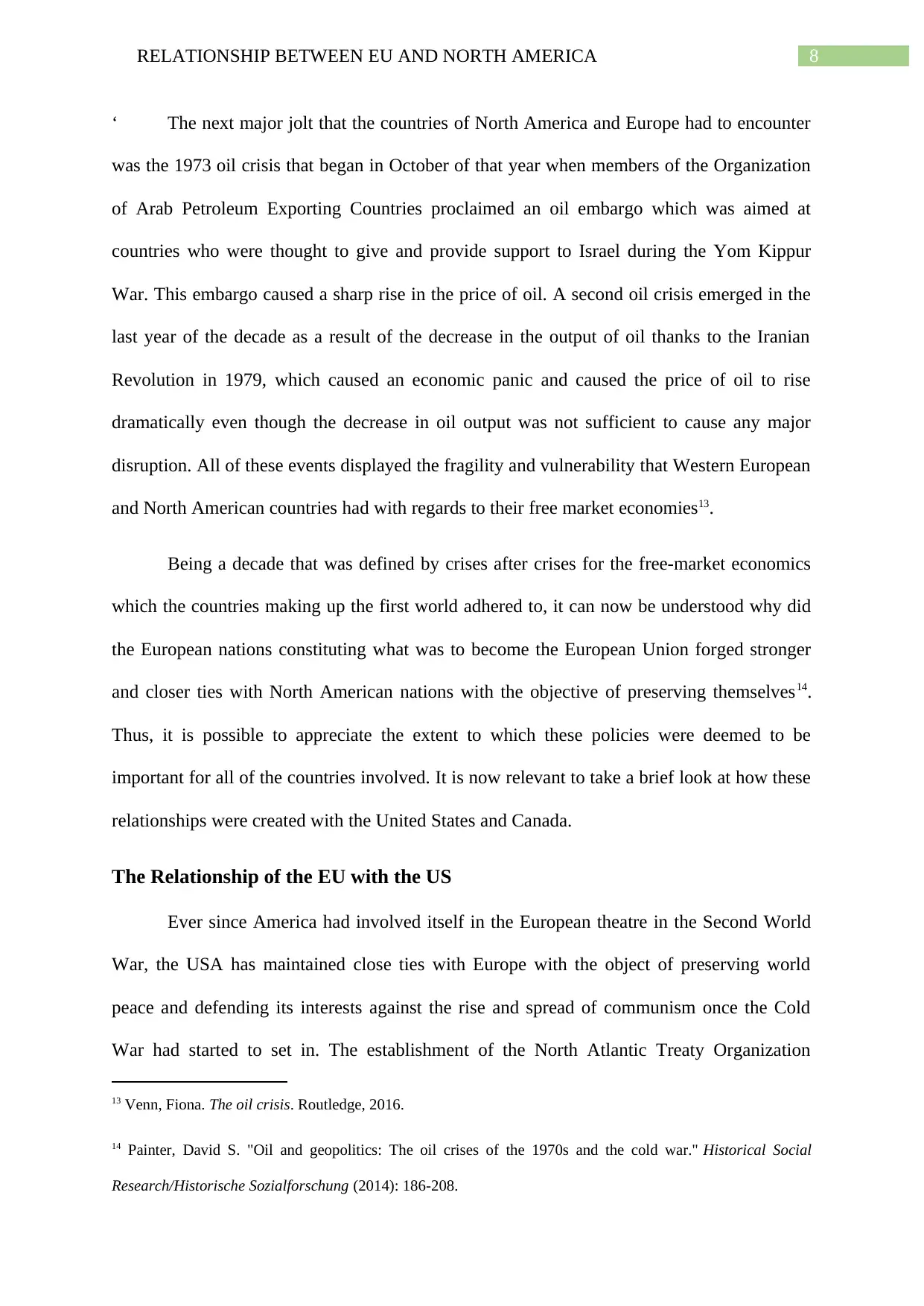
8RELATIONSHIP BETWEEN EU AND NORTH AMERICA
‘ The next major jolt that the countries of North America and Europe had to encounter
was the 1973 oil crisis that began in October of that year when members of the Organization
of Arab Petroleum Exporting Countries proclaimed an oil embargo which was aimed at
countries who were thought to give and provide support to Israel during the Yom Kippur
War. This embargo caused a sharp rise in the price of oil. A second oil crisis emerged in the
last year of the decade as a result of the decrease in the output of oil thanks to the Iranian
Revolution in 1979, which caused an economic panic and caused the price of oil to rise
dramatically even though the decrease in oil output was not sufficient to cause any major
disruption. All of these events displayed the fragility and vulnerability that Western European
and North American countries had with regards to their free market economies13.
Being a decade that was defined by crises after crises for the free-market economics
which the countries making up the first world adhered to, it can now be understood why did
the European nations constituting what was to become the European Union forged stronger
and closer ties with North American nations with the objective of preserving themselves14.
Thus, it is possible to appreciate the extent to which these policies were deemed to be
important for all of the countries involved. It is now relevant to take a brief look at how these
relationships were created with the United States and Canada.
The Relationship of the EU with the US
Ever since America had involved itself in the European theatre in the Second World
War, the USA has maintained close ties with Europe with the object of preserving world
peace and defending its interests against the rise and spread of communism once the Cold
War had started to set in. The establishment of the North Atlantic Treaty Organization
13 Venn, Fiona. The oil crisis. Routledge, 2016.
14 Painter, David S. "Oil and geopolitics: The oil crises of the 1970s and the cold war." Historical Social
Research/Historische Sozialforschung (2014): 186-208.
‘ The next major jolt that the countries of North America and Europe had to encounter
was the 1973 oil crisis that began in October of that year when members of the Organization
of Arab Petroleum Exporting Countries proclaimed an oil embargo which was aimed at
countries who were thought to give and provide support to Israel during the Yom Kippur
War. This embargo caused a sharp rise in the price of oil. A second oil crisis emerged in the
last year of the decade as a result of the decrease in the output of oil thanks to the Iranian
Revolution in 1979, which caused an economic panic and caused the price of oil to rise
dramatically even though the decrease in oil output was not sufficient to cause any major
disruption. All of these events displayed the fragility and vulnerability that Western European
and North American countries had with regards to their free market economies13.
Being a decade that was defined by crises after crises for the free-market economics
which the countries making up the first world adhered to, it can now be understood why did
the European nations constituting what was to become the European Union forged stronger
and closer ties with North American nations with the objective of preserving themselves14.
Thus, it is possible to appreciate the extent to which these policies were deemed to be
important for all of the countries involved. It is now relevant to take a brief look at how these
relationships were created with the United States and Canada.
The Relationship of the EU with the US
Ever since America had involved itself in the European theatre in the Second World
War, the USA has maintained close ties with Europe with the object of preserving world
peace and defending its interests against the rise and spread of communism once the Cold
War had started to set in. The establishment of the North Atlantic Treaty Organization
13 Venn, Fiona. The oil crisis. Routledge, 2016.
14 Painter, David S. "Oil and geopolitics: The oil crises of the 1970s and the cold war." Historical Social
Research/Historische Sozialforschung (2014): 186-208.
⊘ This is a preview!⊘
Do you want full access?
Subscribe today to unlock all pages.

Trusted by 1+ million students worldwide

9RELATIONSHIP BETWEEN EU AND NORTH AMERICA
(NATO) solidified the commitment of the USA in defending Western Europe from any kind
of Soviet-led aggression15. Therefore, as it has been mentioned above, it was natural for the
European Coal and Steel Community to maintain diplomatic and economic ties with the
USA.
By the 1970s, this relationship was strained due to a number of factors. Even though
America had long been involved in Vietnam and they had even helped the French in their
attempt at retaking erstwhile Indo-China, the world-wide anti-Vietnam War sentiment made
inroads both within Europe and the USA, which characterized a good deal of civil unrest. The
United States was coming under increased criticism for its intervention in Vietnam and the
number of war crimes it committed (for example, the My Lai Massacre) drew sharp
condemnation from many nations, including those within Western Europe. Although the
Paris Peace Accord ended American intervention, the failure of the Truman Doctrine to
contain the spread of communism in South-East Asia had clearly failed, which damaged the
prestige of US and European relations to an extent.
The biggest jolt, however, came in the form of the two oil crises that characterized the
decade and broke every idea of capitalism being a healthy and robust system. As it has been
mentioned, the first oil crisis of 1973 kicked off when members of the Organization of Arab
Petroleum Exporting Countries placed an embargo on the export of oil to countries that had
supported Israel. As the countries of Western Europe and the US had been staunch supporters
of Israel and Israeli domestic and foreign policies16, they were hit the most hard by the
embargo. With the rise in price of oil, other essential commodities too experienced inflation
in all of these countries. Although differences did emerge between the foreign policies of
15 Zielonka, Jan. "Transatlantic relations: Beyond the common foreign and security policy." In Revival:
The New Transatlantic Agenda (2001), pp. 65-79. Routledge, 2017.
16 Zanotti, Jim. "Israel: Background and US Relations." Current Politics and Economics of the Middle East 5,
no. 3 (2014): 229.
(NATO) solidified the commitment of the USA in defending Western Europe from any kind
of Soviet-led aggression15. Therefore, as it has been mentioned above, it was natural for the
European Coal and Steel Community to maintain diplomatic and economic ties with the
USA.
By the 1970s, this relationship was strained due to a number of factors. Even though
America had long been involved in Vietnam and they had even helped the French in their
attempt at retaking erstwhile Indo-China, the world-wide anti-Vietnam War sentiment made
inroads both within Europe and the USA, which characterized a good deal of civil unrest. The
United States was coming under increased criticism for its intervention in Vietnam and the
number of war crimes it committed (for example, the My Lai Massacre) drew sharp
condemnation from many nations, including those within Western Europe. Although the
Paris Peace Accord ended American intervention, the failure of the Truman Doctrine to
contain the spread of communism in South-East Asia had clearly failed, which damaged the
prestige of US and European relations to an extent.
The biggest jolt, however, came in the form of the two oil crises that characterized the
decade and broke every idea of capitalism being a healthy and robust system. As it has been
mentioned, the first oil crisis of 1973 kicked off when members of the Organization of Arab
Petroleum Exporting Countries placed an embargo on the export of oil to countries that had
supported Israel. As the countries of Western Europe and the US had been staunch supporters
of Israel and Israeli domestic and foreign policies16, they were hit the most hard by the
embargo. With the rise in price of oil, other essential commodities too experienced inflation
in all of these countries. Although differences did emerge between the foreign policies of
15 Zielonka, Jan. "Transatlantic relations: Beyond the common foreign and security policy." In Revival:
The New Transatlantic Agenda (2001), pp. 65-79. Routledge, 2017.
16 Zanotti, Jim. "Israel: Background and US Relations." Current Politics and Economics of the Middle East 5,
no. 3 (2014): 229.
Paraphrase This Document
Need a fresh take? Get an instant paraphrase of this document with our AI Paraphraser
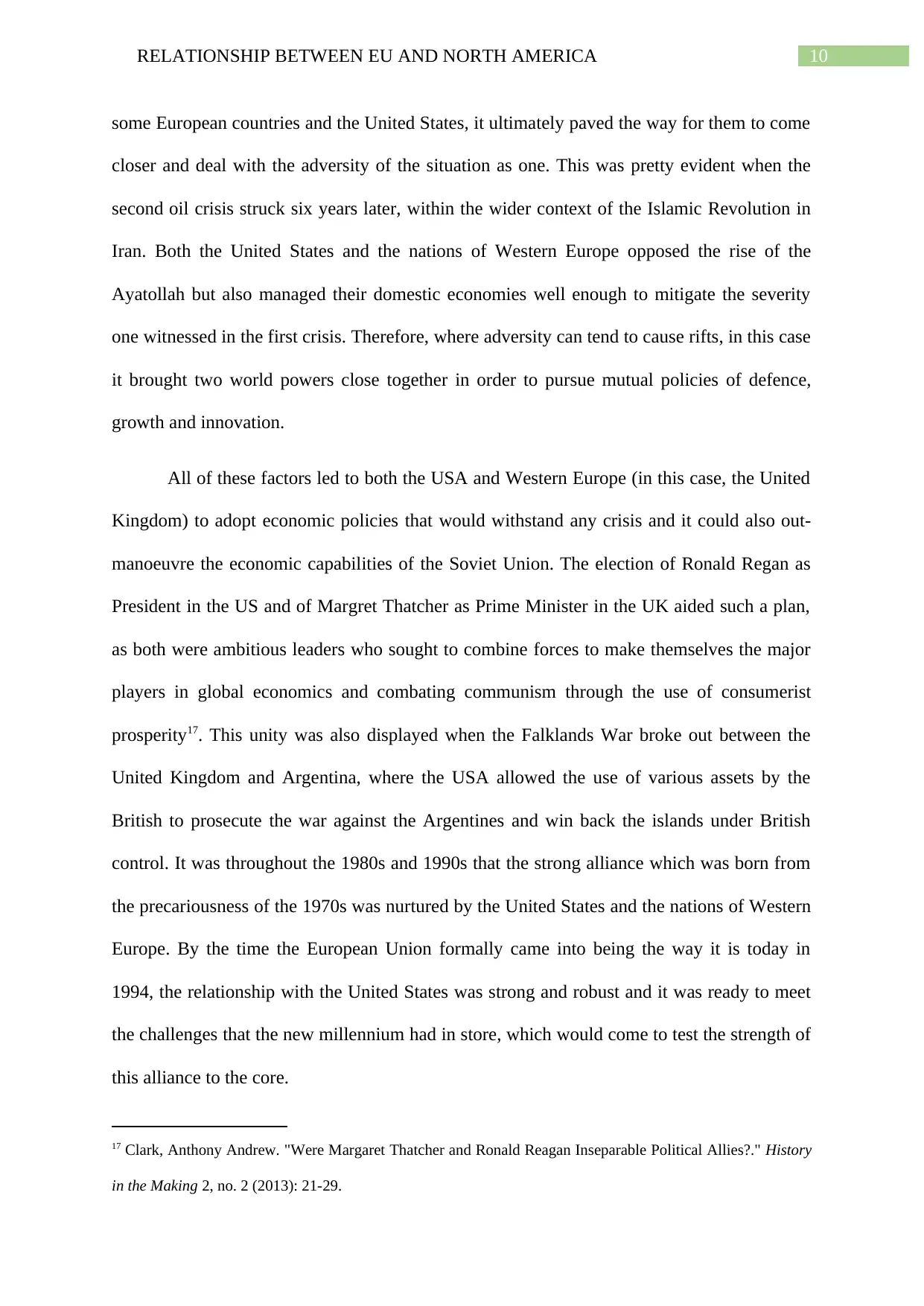
10RELATIONSHIP BETWEEN EU AND NORTH AMERICA
some European countries and the United States, it ultimately paved the way for them to come
closer and deal with the adversity of the situation as one. This was pretty evident when the
second oil crisis struck six years later, within the wider context of the Islamic Revolution in
Iran. Both the United States and the nations of Western Europe opposed the rise of the
Ayatollah but also managed their domestic economies well enough to mitigate the severity
one witnessed in the first crisis. Therefore, where adversity can tend to cause rifts, in this case
it brought two world powers close together in order to pursue mutual policies of defence,
growth and innovation.
All of these factors led to both the USA and Western Europe (in this case, the United
Kingdom) to adopt economic policies that would withstand any crisis and it could also out-
manoeuvre the economic capabilities of the Soviet Union. The election of Ronald Regan as
President in the US and of Margret Thatcher as Prime Minister in the UK aided such a plan,
as both were ambitious leaders who sought to combine forces to make themselves the major
players in global economics and combating communism through the use of consumerist
prosperity17. This unity was also displayed when the Falklands War broke out between the
United Kingdom and Argentina, where the USA allowed the use of various assets by the
British to prosecute the war against the Argentines and win back the islands under British
control. It was throughout the 1980s and 1990s that the strong alliance which was born from
the precariousness of the 1970s was nurtured by the United States and the nations of Western
Europe. By the time the European Union formally came into being the way it is today in
1994, the relationship with the United States was strong and robust and it was ready to meet
the challenges that the new millennium had in store, which would come to test the strength of
this alliance to the core.
17 Clark, Anthony Andrew. "Were Margaret Thatcher and Ronald Reagan Inseparable Political Allies?." History
in the Making 2, no. 2 (2013): 21-29.
some European countries and the United States, it ultimately paved the way for them to come
closer and deal with the adversity of the situation as one. This was pretty evident when the
second oil crisis struck six years later, within the wider context of the Islamic Revolution in
Iran. Both the United States and the nations of Western Europe opposed the rise of the
Ayatollah but also managed their domestic economies well enough to mitigate the severity
one witnessed in the first crisis. Therefore, where adversity can tend to cause rifts, in this case
it brought two world powers close together in order to pursue mutual policies of defence,
growth and innovation.
All of these factors led to both the USA and Western Europe (in this case, the United
Kingdom) to adopt economic policies that would withstand any crisis and it could also out-
manoeuvre the economic capabilities of the Soviet Union. The election of Ronald Regan as
President in the US and of Margret Thatcher as Prime Minister in the UK aided such a plan,
as both were ambitious leaders who sought to combine forces to make themselves the major
players in global economics and combating communism through the use of consumerist
prosperity17. This unity was also displayed when the Falklands War broke out between the
United Kingdom and Argentina, where the USA allowed the use of various assets by the
British to prosecute the war against the Argentines and win back the islands under British
control. It was throughout the 1980s and 1990s that the strong alliance which was born from
the precariousness of the 1970s was nurtured by the United States and the nations of Western
Europe. By the time the European Union formally came into being the way it is today in
1994, the relationship with the United States was strong and robust and it was ready to meet
the challenges that the new millennium had in store, which would come to test the strength of
this alliance to the core.
17 Clark, Anthony Andrew. "Were Margaret Thatcher and Ronald Reagan Inseparable Political Allies?." History
in the Making 2, no. 2 (2013): 21-29.
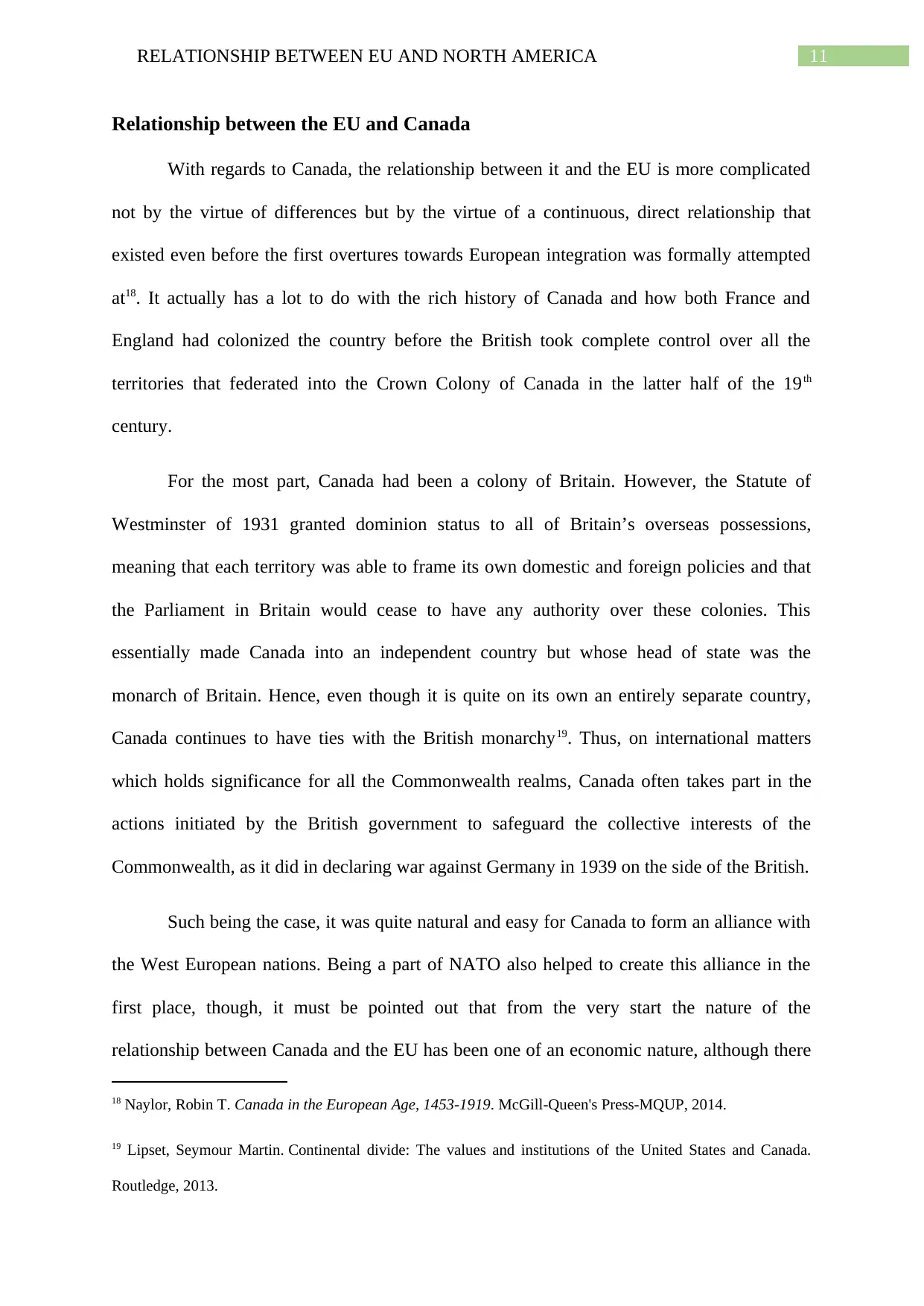
11RELATIONSHIP BETWEEN EU AND NORTH AMERICA
Relationship between the EU and Canada
With regards to Canada, the relationship between it and the EU is more complicated
not by the virtue of differences but by the virtue of a continuous, direct relationship that
existed even before the first overtures towards European integration was formally attempted
at18. It actually has a lot to do with the rich history of Canada and how both France and
England had colonized the country before the British took complete control over all the
territories that federated into the Crown Colony of Canada in the latter half of the 19th
century.
For the most part, Canada had been a colony of Britain. However, the Statute of
Westminster of 1931 granted dominion status to all of Britain’s overseas possessions,
meaning that each territory was able to frame its own domestic and foreign policies and that
the Parliament in Britain would cease to have any authority over these colonies. This
essentially made Canada into an independent country but whose head of state was the
monarch of Britain. Hence, even though it is quite on its own an entirely separate country,
Canada continues to have ties with the British monarchy19. Thus, on international matters
which holds significance for all the Commonwealth realms, Canada often takes part in the
actions initiated by the British government to safeguard the collective interests of the
Commonwealth, as it did in declaring war against Germany in 1939 on the side of the British.
Such being the case, it was quite natural and easy for Canada to form an alliance with
the West European nations. Being a part of NATO also helped to create this alliance in the
first place, though, it must be pointed out that from the very start the nature of the
relationship between Canada and the EU has been one of an economic nature, although there
18 Naylor, Robin T. Canada in the European Age, 1453-1919. McGill-Queen's Press-MQUP, 2014.
19 Lipset, Seymour Martin. Continental divide: The values and institutions of the United States and Canada.
Routledge, 2013.
Relationship between the EU and Canada
With regards to Canada, the relationship between it and the EU is more complicated
not by the virtue of differences but by the virtue of a continuous, direct relationship that
existed even before the first overtures towards European integration was formally attempted
at18. It actually has a lot to do with the rich history of Canada and how both France and
England had colonized the country before the British took complete control over all the
territories that federated into the Crown Colony of Canada in the latter half of the 19th
century.
For the most part, Canada had been a colony of Britain. However, the Statute of
Westminster of 1931 granted dominion status to all of Britain’s overseas possessions,
meaning that each territory was able to frame its own domestic and foreign policies and that
the Parliament in Britain would cease to have any authority over these colonies. This
essentially made Canada into an independent country but whose head of state was the
monarch of Britain. Hence, even though it is quite on its own an entirely separate country,
Canada continues to have ties with the British monarchy19. Thus, on international matters
which holds significance for all the Commonwealth realms, Canada often takes part in the
actions initiated by the British government to safeguard the collective interests of the
Commonwealth, as it did in declaring war against Germany in 1939 on the side of the British.
Such being the case, it was quite natural and easy for Canada to form an alliance with
the West European nations. Being a part of NATO also helped to create this alliance in the
first place, though, it must be pointed out that from the very start the nature of the
relationship between Canada and the EU has been one of an economic nature, although there
18 Naylor, Robin T. Canada in the European Age, 1453-1919. McGill-Queen's Press-MQUP, 2014.
19 Lipset, Seymour Martin. Continental divide: The values and institutions of the United States and Canada.
Routledge, 2013.
⊘ This is a preview!⊘
Do you want full access?
Subscribe today to unlock all pages.

Trusted by 1+ million students worldwide
1 out of 17
Related Documents
Your All-in-One AI-Powered Toolkit for Academic Success.
+13062052269
info@desklib.com
Available 24*7 on WhatsApp / Email
![[object Object]](/_next/static/media/star-bottom.7253800d.svg)
Unlock your academic potential
Copyright © 2020–2025 A2Z Services. All Rights Reserved. Developed and managed by ZUCOL.



